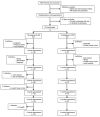The effects of intermittent or continuous energy restriction on weight loss and metabolic disease risk markers: a randomized trial in young overweight women
- PMID: 20921964
- PMCID: PMC3017674
- DOI: 10.1038/ijo.2010.171
The effects of intermittent or continuous energy restriction on weight loss and metabolic disease risk markers: a randomized trial in young overweight women
Abstract
Background: The problems of adherence to energy restriction in humans are well known.
Objective: To compare the feasibility and effectiveness of intermittent continuous energy (IER) with continuous energy restriction (CER) for weight loss, insulin sensitivity and other metabolic disease risk markers.
Design: Randomized comparison of a 25% energy restriction as IER (∼ 2710 kJ/day for 2 days/week) or CER (∼ 6276 kJ/day for 7 days/week) in 107 overweight or obese (mean (± s.d.) body mass index 30.6 (± 5.1) kg m(-2)) premenopausal women observed over a period of 6 months. Weight, anthropometry, biomarkers for breast cancer, diabetes, cardiovascular disease and dementia risk; insulin resistance (HOMA), oxidative stress markers, leptin, adiponectin, insulin-like growth factor (IGF)-1 and IGF binding proteins 1 and 2, androgens, prolactin, inflammatory markers (high sensitivity C-reactive protein and sialic acid), lipids, blood pressure and brain-derived neurotrophic factor were assessed at baseline and after 1, 3 and 6 months.
Results: Last observation carried forward analysis showed that IER and CER are equally effective for weight loss: mean (95% confidence interval ) weight change for IER was -6.4 (-7.9 to -4.8) kg vs -5.6 (-6.9 to -4.4) kg for CER (P-value for difference between groups = 0.4). Both groups experienced comparable reductions in leptin, free androgen index, high-sensitivity C-reactive protein, total and LDL cholesterol, triglycerides, blood pressure and increases in sex hormone binding globulin, IGF binding proteins 1 and 2. Reductions in fasting insulin and insulin resistance were modest in both groups, but greater with IER than with CER; difference between groups for fasting insulin was -1.2 (-1.4 to -1.0) μU ml(-1) and for insulin resistance was -1.2 (-1.5 to -1.0) μU mmol(-1) l(-1) (both P = 0.04).
Conclusion: IER is as effective as CER with regard to weight loss, insulin sensitivity and other health biomarkers, and may be offered as an alternative equivalent to CER for weight loss and reducing disease risk.
Conflict of interest statement
None of the authors have any conflicts of interest.
Figures
References
-
- Colditz GA, Willett WC, Rotnitzky A, Manson JE. Weight gain as a risk factor for clinical diabetes mellitus in women. Ann Intern Med. 1995;122(7):481–486. - PubMed
-
- Willett WC, Manson JE, Stampfer MJ, Colditz GA, Rosner B, Speizer FE, et al. Weight, weight change, and coronary heart disease in women. Risk within the ‘normal’ weight range. JAMA. 1995;273(6):461–465. - PubMed
-
- Renehan AG, Tyson M, Egger M, Heller RF, Zwahlen M. Body-mass index and incidence of cancer: a systematic review and meta-analysis of prospective observational studies. Lancet. 2008;371(9612):569–578. - PubMed
-
- Peeters A, Barendregt JJ, Willekens F, Mackenbach JP, Al Mamun A, Bonneux L. Obesity in adulthood and its consequences for life expectancy: a life-table analysis. Ann Intern Med. 2003;138(1):24–32. - PubMed
Publication types
MeSH terms
Substances
Grants and funding
LinkOut - more resources
Full Text Sources
Other Literature Sources
Medical
Research Materials
Miscellaneous




